Infographic - Chinese Pinyin, the easy and the hard - 3 vs 3
18.10.2013 10:21:05
Didn't you feel relieved at first when you learned that Chinese has pinyin, to help you learn pronunciation? Many learners of Chinese even feel in the beginning that they could spare themselves a lot of effort if they just settle with learning pinyin, and forget about the characters.
It doesn't work that way though. If you want to learn proper Chinese conversation skills, you will have to get acquainted with the characters. That being said, let's look at the third section of the infographic on Chinese pronunciation and pinyin, which focuses on pinyin only.
What makes pinyin easy?
No Strange Symbols
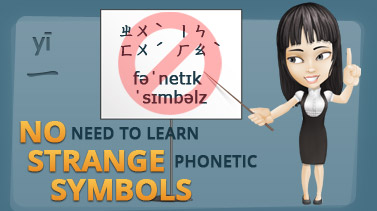
For one thing, we don't have to learn a whole new set of letters, symbols or characters. We are already familiar with all the letters in the pinyin system.
Pinyin isn't the only sound script out there. Take a look at what Daidai is teaching in the illustration here. Can you read the two first lines of.. well.. script? It is written in Zhuyin (aka "bopomofo"). Its pinyin equivalent would be "zhùyīn fúhào". So which do you prefer to learn?
Both pinyin and zhuyin is just a set of phonetic symbols carrying no meaning other than pure pronunciation. English has the same, since not all written words are pronounced exactly as they are written. Take an example, how do you pronounce the English word "read"? That would depend on the context. In some cases it must be pronounced like the word "red", whereas in other contexts it must be pronounced like the word "reed".
Are you able to read the last two lines of symbols in the illustration? What does it mean? It is in fact "soundscript" for the English words "phonetic symbols".
So the first good thing we can say about pinyin, is that it is quick to get started with. Just compare it with Zhuyin or even English phonetic symbols.
Fluency Quickly
 With a somewhat limited effort and short period of time, you will be able to achieve fluency in pinyin. You will be able to read it quite fast, even though you may not pronounce it all perfectly right.
With a somewhat limited effort and short period of time, you will be able to achieve fluency in pinyin. You will be able to read it quite fast, even though you may not pronounce it all perfectly right.
Achieving fluency is a good thing when you're in class, reading a message for a Chinese person - perhaps a taxi driver, or even if you, as part of some meeting, have to read or convey a written Chinese message.
Masterable
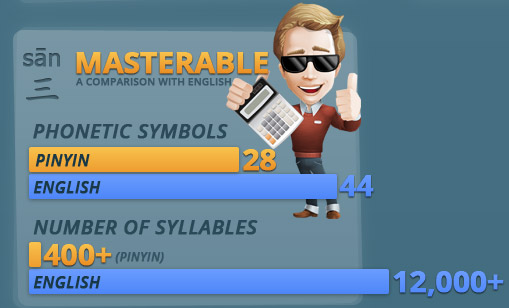
Here is both a fair and an unfair comparison between pinyin and English. If you take a close look at this, it might make you feel that getting to grips with pinyin is really not bad at all.
Phonetic Symbols
Let us first compare the number of symbols in pinyin and in an English phonetic system.
Pinyin has just 28 different basic symbols, whereas English has 44. These two numbers are directly comparable, since we're not comparing the very languages, just the phonetic symbols.
This is particularly interesting because many feel that there are so many very difficult sounds in Chinese. The fact is that Chinese has fewer sounds than English.
Number of syllables
This comparison is actually not really fair. You see, this comparison is between pinyin (sound script only) and English (the very language). The reason why it is still included here, is that quite a few western learners of Chinese decide to focus so heavily on pinyin, that they somewhat tend to see pinyin as the written language itself. While that cannot be recommended, lets get back to the comparison.
Ever thought of how many different syllables you'll encounter in English? A staggering 12.000, or even more! In pinyin there is just roughly 400. So you would actually be able to memorize the whole set of pinyin syllables, even without super-brain powers.
Could there possibly be any downsides to pinyin? Let's take a look.
What makes pinyin hard?
Pinyin is great, but it has some features that really make up some pitfalls for learners.
Learn ABC Again
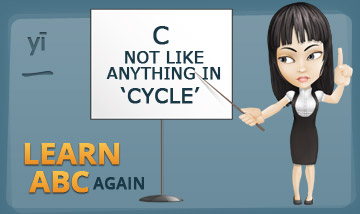
The nice thing about pinyin is that you don't have to learn a whole new set of symbols or letters. But the downside to it, is that you would very likely have to put in a real struggle, in order to "unlearn" the pronunciation of some letters.
As an example, take the letter C, whether in the pinyin initial CH or just C, it is never pronounced like any of the C's in the English word 'cycle'. So every time you encounter the letter C, while reading pinyin, you must forget what you were taught from childhood regarding the letter C and apply the Chinese pronunciation on it instead. This can be troublesome.
The Fake 'I'
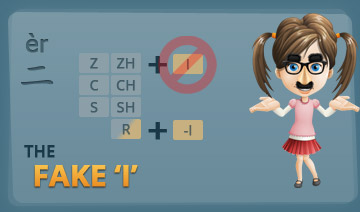
One of the very common pitfalls is the fake I. In fact, in pinyin there is the letter I and the letter -I. What is that supposed to mean?
You should really take a closer look at the Standard Mandarin pinyin chart. You can download and use the chart for reference free of charge here. Check out the two different columns with the finals 'I' and '-I'.
The thing is that the 'I' is pronounced like the 'ee' in 'bee'. This is not always the case however, if it is part of a pinyin syllable beginning with any of the following initials: Z, C, S, ZH, CH, SH, R.
So what is it pronounced like then? Actually, I'd prefer you to hear the sound for yourself. Just type in something like "SHI" in the "pinyin pronouncer" on the Standard Mandarin home page, and you can hear it. It is free.
The Standard Mandarin software also provides in-depth description of how to produce this sound.
'Ü' The Treacherous
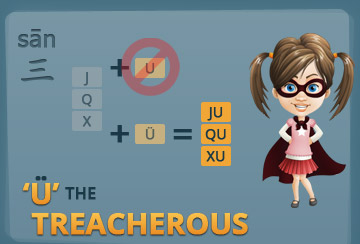
Another tricky letter in the pinyin system is the letter U, or Ü rather.
The letter Ü is especially tricky because in some cases it is written exactly as it is, with the umlaut dots. But in most cases it is rewritten as a regular U. This causes a lot of misreadings.
If the Ü is part of a syllable beginning with L or N, then it is not changed.
But if it is part of a syllable beginning with J, Q or X then the dots are simply omitted. Why? To save ink? Well, probably to make writing pinyin faster. The thing is that J, Q and X will appear in a syllable together with the regular U.
So whenever you see the J, Q and X together with a U, then remember that it is not really a U but a Ü.
Pinyin is great. It makes getting started with Chinese so much easier. It also has its pitfalls though. Don't just ignore the pitfalls, but get to know where they are, and cope with them. That will make you pinyin superstar!
Did you enjoy this little ride through the third section of the infographic on Chinese pronunciation and pinyin in plain English?
Check out the whole infographic here. The third section of it is right below.
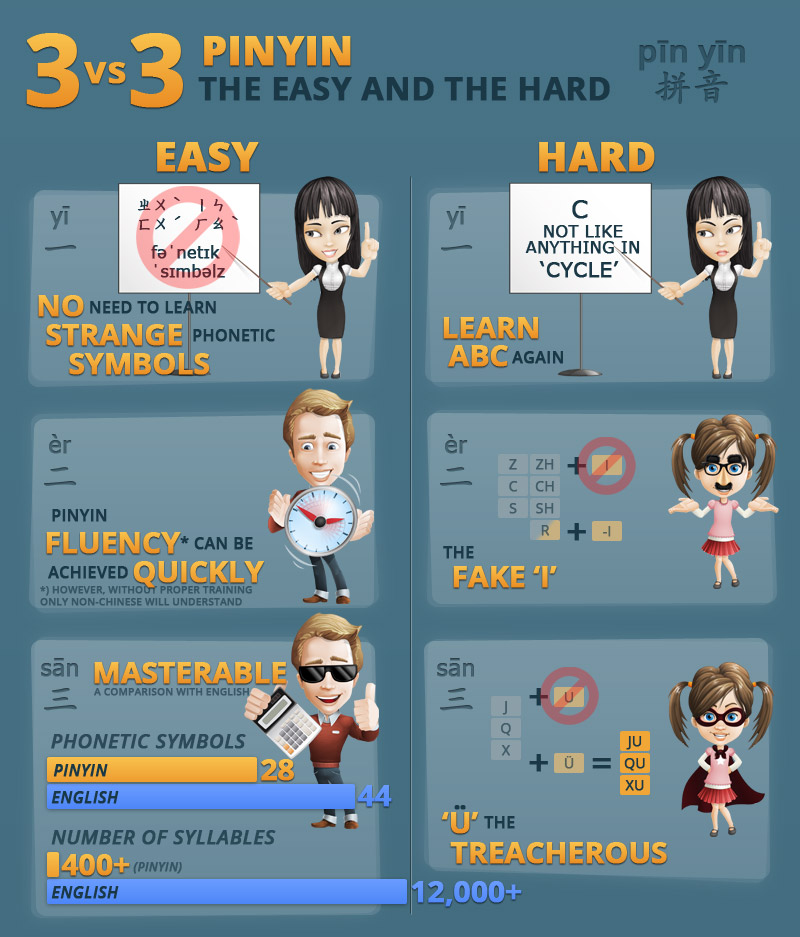

Did you like this page?